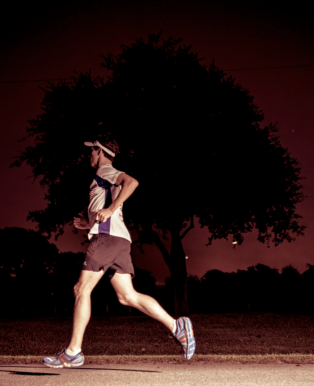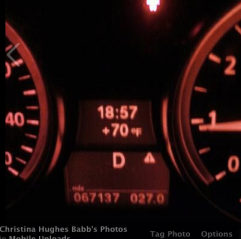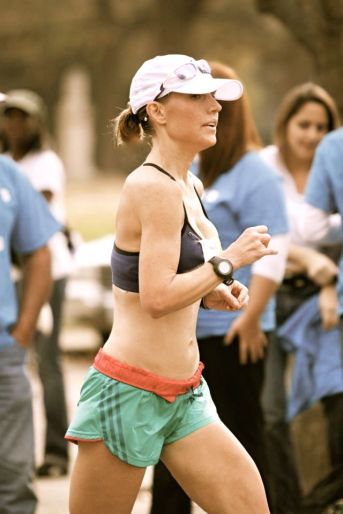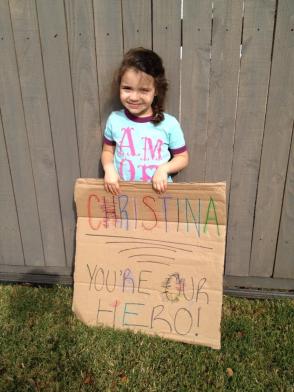This story originally is published in the December 2013 Lake Highlands Advocate and East Dallas Advocate magazines.
A freak accident left him burned, broken and dependent, but this White Rock-area runner intends to finish what he started training for two years ago — the Dallas Marathon
On a cool November morning, Brandon Cumby rounds the last turn of the Dallas Running Club Half Marathon at White Rock Lake. Feeling better and stronger than he’s ever felt in a race, he smiles at the breaking sun and crosses the finish line in 1 hour, 51 minutes and 14 seconds.
His time places him at a nondescript 416 among male finishers. But considering where the 33-year-old runner was little more than a year ago — facedown in mud, spewing blood from multiple orifices, nose and ribs broken, flesh smoldering, no discernable pulse — the finish ranks him decidedly outside the realm of ordinary.
The accident
In summer 2012 Cumby began training for the Dallas Marathon, but his plans screeched to a halt in August. Cumby cannot cohesively recall anything between July 28 and Aug. 24, he says. But family members and friends help him piece together the events that nearly snuffed out his future.
On Aug. 13, a Monday, the air conditioner in Cumby’s car died. After leaving the North Dallas office where he worked as an accountant, Cumby stopped at his friend Scott Boyle’s house. He figured he could park in Boyle’s driveway, hopefully fix the blower and avoid a sweltering drive home.
While Cumby toiled under the hood, Boyle and mutual friend Michael Baker played with their new toy — a high-tech remote-control helicopter.
By the time Cumby joined them, the sun was sinking, and visibility was low.
“They were ready to take it in — they didn’t want to crash it. It was expensive. They’d pooled their money to buy it. But I asked them to do a couple more runs. I egged them on, telling them to fly higher, do crazier stunts.”
Promptly, the copter crashed into a nearby tree, embedding itself in the uppermost branches.
Boyle went for a ladder.
Cumby, confident in the strength gained from his marathon training, and feeling responsible, was determined to climb and retrieve the object himself.
In fractured flashbacks, Cumby recalls ants biting his hands as he climbed the tree, looking way down at his friends and feeling the first pang of anxiety, seeing the power lines in the distance (avoid, he noted to himself).
He couldn’t get to the helicopter, he assessed. But he could climb close enough to loosen it from the branches, if only he had something long with which to prod it.
A neighbor who had joined the guys below handed him an aluminum pool-skimmer pole. Perfect.
He was clutching the pole with his right hand when his foot slipped. Falling in the direction of the wires, he lost control of his arm, which launched the pole over his head and into a power line.
A deafening “hmmmmmm!” shot through the air.
The hum was so powerful it made your teeth chatter, the witnesses say.
Then there were flames — orange and blue, that looked like they were shooting from Cumby’s belt buckle and from behind his knees, Baker recounted.
Then he fell, maybe 20 feet, “like a rag doll doing a gainer,” one witness later told him.
Motionless, Cumby lay prostrate. Boyle rolled him over; Mud clogged Cumby’s mouth, blood gushed from his nose and face, he was black and blue, smoke was rising from his groin and he smelled like burning flesh.
Boyle, a onetime lifeguard, searched for a heartbeat, a pulse. Nothing. He began chest compressions and kept working until paramedics arrived.
EMTs intubated, defibrillated, pounded Cumby’s chest until, finally, mercifully, his heart sprung to life.
But Cumby still was in grave danger. He was bleeding internally.
His friends say that even in his bed at Parkland Hospital, blood was seeping from his nose and mouth, from everywhere, it seemed.
The doctors could operate, they told Cumby’s loved ones, but his chances were not good. As his family waited with the hospital chaplain, a team of surgeons administered 22 units of blood and, against the odds, repaired Cumby’s lacerated liver and abdominal wall well enough to keep him alive. Later, burn and trauma surgeon Dr. Francis Ali-Osman later told Cumby that 100 out of 100 other people in his situation would have died before surgery.
Alive, but not well
The days and weeks following the first operation were the most mentally and physically agonizing of Cumby’s life, he says.
He was released from the hospital temporarily at the end of August. In his condition, he could not live alone, so he moved in with his grandparents. Clothing felt like sandpaper on his sensitive skin. Movement was nauseating. Stillness was unbearable.
“The pain and swelling from my burn excisions was unbelievable — I couldn’t tolerate walking or sitting down without one of those donut-shaped pillows.”
He couldn’t sleep, experienced hot and cold flashes, and lacked an appetite. A walk to and from the bathroom exhausted him.
“Before I had the accident I was fit. I rode a Harley, played the guitar, ran, cycled, worked on building lean muscle … I had lived on my own since I was 22, had relationships, had a house, was financially independent. Now I couldn’t live by myself or cook my own meals, drive or wash my clothes. I took medication out of a daily pill sorter so I wouldn’t get mixed up.”
And there was this hole in his gut, he says, whose source was anxiety over the idea that he might never run another mile.
But there is no space left in your head for marathon dreams when, say, the open wound located near your genitals inflames and oozes blood.
During a trip to the Parkland emergency room, Dr. Ali-Osman told him the wound wasn’t closing — it is called dehiscence. Cumby would just have to give it time.
“The anxiety of having an open bleeding wound in a sensitive area is worse than the wound itself,” Cumby says.
Before his groin-area wound healed, he was readmitted to the hospital because, once it became clear he would live, surgeons needed to mend several sinus and facial bones broken during the fall (fractured rib and cervical bones also were dealt with separately).
This time, doctors cut a line from one ear, over his shaved head, to the other. They folded down the skin, repaired the bones — adding synthetic bone filler and wire mesh where needed, Cumby explains — and sewed him back together.
Seemingly endless sleepless nights and sickening withdrawal from opioid medicines — tremors, insomnia, nausea and increased sensitivity to pain — followed.
For weeks, his face remained swollen beyond recognition. He weighed 143 pounds, down 30 from his training days.
Several mornings on end, he had his stomach pumped — exploratory measures to determine the effectiveness of his digestive system. Unbearable abdominal pain sent him to the emergency room on multiple occasions. Digestive distress and stomach pain are results of postsurgical ileus and abdominal adhesions, respectively, Cumby explains.
Through it all, doctors prodded Cumby for information.
“They seemed to wonder how I had survived,” he says. “Their best guess is that my fitness, the running, saved me.”
Two weeks after his release from the hospital following cranial surgery, Cumby snuck out of his grandparents’ house. He needed to run.
“I made it about a half mile before I had to lie down in the grass. I was wearing a heart-rate monitor, and it was going crazy. I walked home.”
A couple of days later he tried it again, with similar results. His mom, though she didn’t understand why he needed this so much, began walking with him, and they eventually began adding small jogging intervals.
Running therapy
Even as he was recovering from electrocution and life-altering trauma, Cumby felt this undeniable urge to run. Why? “I don’t expect anyone who is not a runner to understand this,” he says.
“When I first got out (of the hospital), I was entirely focused on the physical components. I wanted things to quickly return to normal. I needed to go back to work, get in shape, get my own place, make things look and feel normal. Turns out, there’s no quick way.”
Going out too fast can be detrimental in a long-distance race. Same goes for recovery, Cumby says.
He realized he had to go back and build a stronger foundation before he could rebuild his life, he says.
“So I asked myself, ‘What brings you joy?’ That is a good place to start.”
And his answer was: running.
“Running empowers me, centers me, focuses me,” he says.
The exercise strengthens his atrophied muscles and weary heart, but he says it is about much more.
“People think running is physical. It’s not. Most of it is between the ears.”
When he first started running years ago, he learned that.
“At that time, I was overweight, ending a marriage, unhappy, so I started running. Back then, I did my best thinking while I was running,” he says. “It is no different now. It is my Zen.”

The marathon
Rebecca Baker is Cumby’s running partner. In 2012 the duo decided to train for the Dallas Marathon.
After Cumby’s summer 2012 electrocution, which was witnessed by Rebecca’s husband Michael, the Bakers only wanted their friend to survive.
“Everything was so touch and go for the first few days that we were more worried whether he would live,” Rebecca recalls. “It took a couple of days for them to figure out that he didn’t have any significant spinal injuries, which meant that he would walk again. At one point, he was so disoriented that he thought he had overslept and missed the marathon start. He kept telling his mom he needed his water bottle. Clearly, running was never far from his mind.”
Rebecca says she wasn’t all that surprised when he resumed training. “I was worried that he would try to do too much too soon, but he has done pretty well this season.”
The running community rallied around Cumby after the accident. The Dallas Running Club and White Rock Running Co-op held a fundraiser to help with medical expenses.
In January 2013, the Bakers and Cumby’s lifelong best friend Aaron Stevens (a Lake Highlands resident whose birthday, Cumby points out, fell on the same day of the accident), joined Cumby for a 5k race.
“It took 33 minutes to finish, and I thought I would die,” Cumby says. “But that got me over a mental hurdle.”
He didn’t like being slow, though.
“I am my own worst critic. I look at the other guys in my age group and their race times and feel inferior,” Cumby notes.
However, both he and Rebecca acknowledge that the way he is running now, all things considered, is nothing short of a miracle.
In March, Cumby ran the Rock n’ Roll half marathon in a little over two hours.
Then he registered for the Dallas Running Club’s training program for the December 2013 Dallas marathon.
As the miles increased and Dallas marathon hopefuls ratcheted up the calorie, carb and protein intake, Cumby ran into trouble.
In August he landed in the ER with severe pain and vomiting blood.
His doctor wanted to operate to remove scar tissue growing around Cumby’s intestine.
Cumby begged for an alternative.
“The doctor looked at me like, ‘Let me get this straight. You are refusing surgery because you do not want to interrupt your marathon training?’ and I say, ‘Yes’.”
The doctor made a deal. They would try one more thing, and if his symptoms improved, he could resume training. Cumby said he would try anything.
The treatment was dietary — Cumby would go on a strict low-carb, low-protein, high-fat diet.
To avoid mid-workout distress, he also started fasting for several hours before any long-distance run. The diet essentially goes against everything marathon coaches preach, Cumby says.
But it has worked.
Before racing the DRC Half Marathon in November, Cumby completed a 21-mile training run with the running club’s 4:10-marathon pace group.
When he runs the 26.2-mile Dallas Marathon course on Dec. 8, he won’t be wearing a watch, he says.
“I don’t want to put any undue pressure on myself by worrying about how fast or slow I am running,” he says. “I am just going to concentrate on finishing the race.”
As he expected, while he focused on running over the last few months, Cumby’s life shaped up. He recently got his own place near the lake — the epicenter of Dallas fitness, he calls White Rock — and a new job at a small firm.
He’s learned some lessons: No tree-climbing with aluminum poles. His friends and family are too good to be true. Follow joy. Forget the odds. Do not make specific plans, because you risk short-changing yourself.
After the marathon, he might try ultrarunning or a triathlon, he says.
“I want to see how far I can go.











